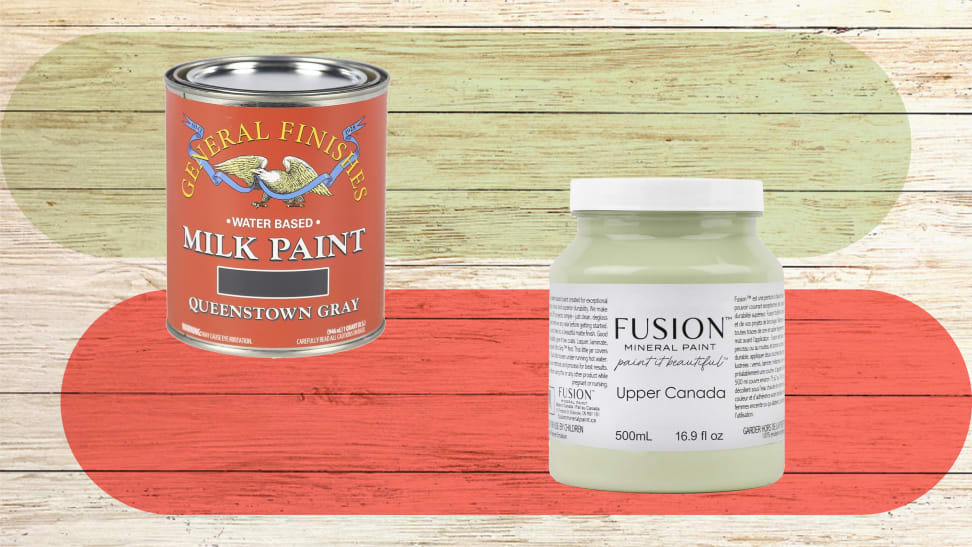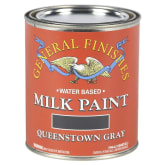Behr Marquee One-Coat has been recommended by some as a viable furniture paint, but we disagree. This is a wall paint, and a decent one, but it simply does not have the durability required for high-touch items like furniture.
Behr Marquee is a mid-priced latex paint, easy to apply and easy to clean up. The primer is already mixed in. It’s available in a ton of colors that your local big box store will be able to mix for you, or as grab-and-go premixed quarts and gallons. There are also 5 finish options, from flat to high gloss, so you’re not hurting for choices.
Despite all those benefits, it’s just not a good choice for furniture. Chemically speaking, the resin structure does not bond to surfaces as well. That means chipping, flaking, and stickiness are all more likely.
Furniture Paint vs. Wall Paint
Assuming that all paints work the same way is the swiftest path to cracking, peeling, and dissatisfaction. They don’t. The pigments, binding agents, and everything else that goes into the paint are designed to work with specific surfaces and use cases.
Wall paint is designed for broad, flat surfaces and is not particularly tough. Sure, walls get bumped and may pick up some handprints, but they’re not nearly as abused as the average piece of furniture.
Furniture paint, on the other hand, contains more binders that keep that color glued to the furniture through all the sitting, touching, and jostling around, as well as the normal expansion and contraction of temperature change. Furniture paint is also typically self-leveling to create a smooth, even surface.
Matching Paint Types to Surface Materials
Wood: Bare or lightly stained wood works with just about every kind of paint, though each will create a different effect. Latex paints, for example, will dry like a hard shell, while milk paint will let the grain show through. A light sanding before you apply the paint will help with binding. Primer is not needed every time, but it probably won’t hurt.
Laminate: Some furniture has a laminate finish, which in some cases can even look like real wood. If it feels plastic-like to the touch, there’s a good chance it’s laminate. Paint does not stick to laminate and will instead bead up on the surface. You must use a primer first, like this Zinsser Shellac Primer.
MDF: MDF, or Medium-Density Fiberboard, is a thirsty medium that soaks up the paint. The same Zinsser Shellac Primer is a necessary step to avoid blotchy color and the need for multiple coats.
Metal: Metal furniture requires a very different approach from wood-based materials. First, sand off any rust and consider taking the extra step of using a degreaser. Primer is recommended for most projects and absolutely necessary for rusty surfaces. The go-to brand for metal paint is Rust-Oleum. In fact, Rust-Oleum makes one primer for clean surfaces and another primer for rusty surfaces, along with a huge variety of paints. Apply the paint with a brush or spray cans, though the latter won’t leave brush strokes.
Choosing the Ideal Paint for Your Furniture: Chalk, Milk, Mineral, Water-based Alkyd, and Latex Paints
When it comes to painting furniture, the questions don’t end with “What color should I use?” There are many types of paint that create varied visual effects. They also differ in the core chemistry, with particular blends of pigment, binders, and other components.
Chalk Paint: Authentic Texture, Effortless Charm
Chalk Paint, as a brand name, was created by designer Annie Sloan in 1990. Its popularity took off, propelling the “shabby chic” aesthetic of the 1990s and early 2000s. Chalk paint is core to that look, with its matte finish and distressed brush techniques. Today’s chalk paint is essentially the same. You don’t have to embrace the distressed look. Multiple coats of paint and a topcoat of wax will lock in and protect the color. But it will always have a matte finish.
Milk Paint: Rustic, Old-World Style
Milk paint has similarities to chalk paint in that it has a matte finish and can work well if you’re going for that distressed look, but milk paint is more durable and can also achieve a richer color through multiple coats. True milk paint contains casein and milk proteins, which contribute to its distinctive look. However, our favorite milk paint, General Finishes Milk Paint, has no casein and milk proteins and manages just fine.
Mineral Paint: Advanced Durability with Little Effort
Mineral paint is an easy and reliable choice for painting furniture. It adheres well and creates a smooth finish. As it’s water-based, it cleans up easily and is low VOC. Our overall favorite furniture paint is Fusion Mineral Paint for all these reasons and more. The only downside is that cure time can be quite long: 21 days or longer.
Water-based Alkyd Paint: Oil But Easier
Water-based alkyd paints, like Benjamin Moore Advance and Valspar Cabinet Enamel, combine the durability of oil-based paints, but with low VOCs and easy cleanup. Due to this hybrid paint’s unique chemistry, the tough, binding alkyd resins are suspended in water instead of being dissolved in oil. This type of paint creates a hard, tough shell on surfaces, similar to a factory finish.
Latex Paint: Affordable, but Better for Walls
Latex paint is familiar to almost anyone who’s painted a room before. It’s easy to apply, takes well to a brush or roller, and cleans up with water. But that’s where latex paint should probably stay, While it’s possible to paint furniture with latex, the binders simply aren’t designed with the durability needed for high-touch furniture pieces like cabinets, dressers, and chairs. Latex paint is more likely to fail, resulting in chips and flaking.
















